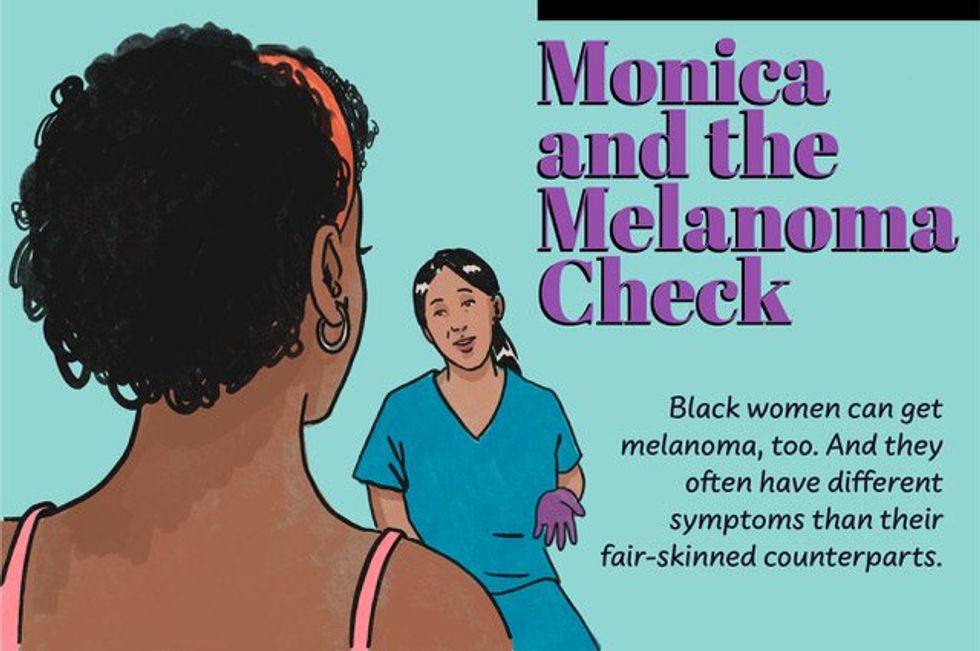

Image
Dialogue
Two black women (Monica and Brandi) are sitting at a table in an outdoor cafe having lunch together and chatting.
Monica: What are you wearing to Stacey’s party next month?
Brandi: Probably a black dress. The one who has –
Monica: (picks up her glass of water, revealing a dark stain on the palm of her hand)
Brandi: Monica, what do you have in your hand?
Monica: This place? (points to a point on the palm). I’m not sure. It seemed to appear only one day. And you know what? In fact, it’s been bothering me lately. It’s itchy and a little sensitive.
Brandi: Have you had it checked?
Monica: No. I’m sure it’s no big deal.
Brandi: That reminds me a little of how Stacey said it was her skin cancer.
Monica: But she’s light-skinned. Darker-skinned people like us don’t have to worry about that. I never get burned.
Brandi: Yeah, but I think you should at least get it looked at.
Monica: Well, in a few weeks I’m going to the dermatologist to try one of those laser skin resurfacing treatments. I can mention it then.
Monica is sitting in the examination chair at the dermatologist’s office. He’s finishing up one of those fancy laser treatments on his face.
A couple of weeks later…
Doctor: Everything ready! This should help combat some of those fine lines you’re worried about.
Monica: Oh, before I left, my friend made me promise to ask you about this stain on my hand. I told him it was nothing, but can you take a quick look?
Monica’s dermatologist takes a magnifying glass, adjusts his headlamp to illuminate her palm, leans forward, and examines the mole on her palm.
Monica’s doctor takes a quick sample of skin from the mole and packages it for a biopsy.
Doctor: This actually seems a little suspicious.
Monica: Really? How does it look?
Doctor: It could be early melanoma.
Monica: In the palm of my hand?
Doctor: Yes. In people with darker skin, melanoma actually appears more in areas that don’t get a lot of sun, such as the palm of the hand, the soles of the feet, under the nails, or even inside the mouth.
Monica: I had no idea. I barely wear sunscreen unless I’m at the beach or something because my skin never seems to burn.
Doctor: Many people of color don’t realize that they are also prone to skin cancer. And that not all skin cancers are caused by sun exposure. It’s true that lighter skin is at greater risk, but I also diagnose it in black people, even those who never burn. I’m going to have a biopsy and will call you with the results.
Monica receives a phone call from the doctor.
Monica: Hello?
Doctor: Hello Monica. Just as I suspected, that mole is an early stage melanoma. The good news is that you let me know and we caught it early. I’m going to schedule you to come and have it removed.
Monica: Wow. I’m so glad I reviewed it.
Doctor: Yes, it’s great that you brought that mole to my attention. Go for annual checkups, monitor your skin between appointments, and definitely come see me if you notice anything more suspicious.
Additionally, although sun exposure probably did not cause this melanoma, it is still important to use sunscreen. Use SPF 30 or higher. You will want to find a brand with zinc oxide and/or titanium dioxide. Zinc can leave a white tint on the skin, but produces tinted tints for people of color.
Monica: Thank you!
Monica is at Stacey’s party with her friend Brandi. They are standing together at a high cocktail table with a drink in each hand chatting. Brandi is wearing her black dress and Monica is dressed too. The party is outside on a rooftop and the sun is still out.
Monica puts on sunscreen and offers some to Brandi
Monica: Thanks again for encouraging me to get that mole checked, Brandi.
Brandi: Of course. I am very glad that the surgery was resolved. A great reminder to put on sunscreen. Honestly, I’ve been slacking too.
Monica: Speaking of which… (pulls out a tube of SPF 30, smears some on her exposed skin, and offers it to Brandi).
Brandi: Thank you!
Possible symptoms of skin cancer in people of color
-
A dark spot, growth, or patch of skin that changes shape, gets larger, or bleeds
-
An area of rough or dry skin
-
A dark line at or around the base of the fingernail or toenail
-
A sore that does not heal or does not heal and returns over time.
-
A sore that appears or reappears at a scar or site of a previous injury.
For more information, visit HealthyWomen.org.
This resource was created with the support of Merck.







